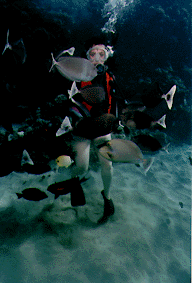|
3. Learn to control your weight and buoyancy.
Master the art of buoyancy control and your dives will be more enjoyable,
less strenuous and less environmentally damaging. Proper weighting for your
exposure suit will allow you to rely less on your buoyancy compensator.
You will not have to fight your equipment and you will have more time and
air to enjoy the scenery.
4. Streamline your equipment.
Keeping gear to a minimum and keeping accessories such as consoles and octopuses
tucked in will let you move through the water with ease. Dangling equipment
can smash corals or become
snagged, panicking the diver and ruining the coral.
5. Marine life should be seen and not touched.
Your touch will disturb or destroy just about anything you are likely to
come in contact with. So avoid or minimize all contact with the [ocean floor]
and with marine life. Remember, you are a guest in their home.
6. Do not choke the reef with sand.
When you are looking ahead, it is easy to forget those things on your feet
but you can easily break off pieces of reef with a thoughtless kick or choke
corals with a burst of sand stirred up by vigorous finning. Choosing the
right sized fins can help, as can better buoyancy control.

7. Anchors destroy coral.
Never anchor on reefs or tie onto coral heads. Repeated anchoring on coral
will destroy what a diver wants to see. Use established moorings and, if
these are occupied, move to another site. If no moorings are available where
you want to dive, help everyone by starting a petition for their construction.
Meanwhile, anchor on the [ocean floor] sand.
8. Shells and coral are more useful in the ocean than in your collection.
Coral reefs are finely-tuned ecosystems inhabited by creatures that perform
many services for one another. It is a delicate economy in which everyone
plays an important role. Nothing is wasted. By removing even the most insignificant
piece of coral rubble, you may be disrupting this fragile system. Empty
shells are movable homes to hermit crabs.
9. Think about what your photo can do to help the environment.
Whenever you dive, you are bound to have an impact on the undersea environment
and when you take photos or video footage, you are bringing away a piece
of the spirit of the sea. Do not become preoccupied with taking a photo
and try not to touch the reef or disturb the subject. Think about how that
image might help protect the ocean that has given it to you.
10. Be an ambassador of the environment.
As a diver, you are part of a tiny privileged minority of humankind that
knows the glory of the undersea world. Communicate your enthusiasm and your
concern for the sea. Use your expertise and photos to correct those who
do not respect the health of the oceans. Get involved in diver awareness
and marine protection programs.
| 

